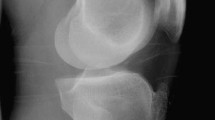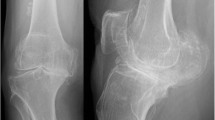Abstract
Purpose
This study aims to compare the microfracture (MF) technique with the bioscaffold solution application (BST-CarGel) in treating femoral chondral lesions.
Methods
Thirty-eight patients ages 18–45 with isolated single femoral condyle full-thickness (ICRS grade 3–4) chondral lesions were included in the study. Patients were divided into two groups as MF applied (Group I = 21) and bioscaffold combined with MF (Group II = 17). The visual analog scale (VAS), Western-Ontario, and McMaster Osteoarthritis Index (WOMAC) were used in clinical evaluation. The location, size, and depth of lesions were evaluated with preoperative magnetic resonance imaging (MRI). Magnetic resonance observation of cartilage repair tissue (MOCART) score was used for postoperative evaluation.
Results
The mean age was 32.5 (range 19–44) years. Mean follow-up was 14.9 months (range 12–24). Lesion size was 3 cm2 in group I and 2.9 cm2 in group II. There were no differences between groups regarding demographic characteristics but BMI (Body Mass Index) was lower in group II which was significant. The duration of surgery was longer in group II (p < 0.001). Postoperative statistical significant improvements were found in WOMAC and VAS scores in groups, but there was no statistical difference. Although there was no significant radiological difference in the group II according to the MOCART score, higher scores were obtained compared to group I.
Conclusion
No difference was found, clinical and radiological, in terms of short-term outcomes. MF is a method to be applied as a primary treatment with its cost-effective, simple and short surgery technique, and effective clinical results up to 4 cm2.
Level of Evidence
Level III: retrospective comparative study.



Similar content being viewed by others
Data Availability
The authors confirm that the data supporting the findings of this study are available upon reasonable request.
References
Hjelle, K., Solheim, E., Strand, T., Muri, R., & Brittberg, M. (2002). Articular cartilage defects in 1000 knee arthroscopies. Arthroscopy, 18(7), 730–734.
Andriolo, L., Crawford, D. C., Reale, D., Zaffagnini, S., Candrian, C., Cavicchioli, A., et al. (2020). Osteochondritis dissecans of the knee: etiology and pathogenetic mechanisms. A systematic review. Cartilage, 11(3), 273–290.
Steinwachs, M. R., Guggi, T., & Kreuz, P. C. (2008). Marrow stimulation techniques. Injury, 39(Suppl 1), S26-31.
Mats, B., Andreas, H. G., José, A. C., Jack, F., Martin, L., & James, H. (2016). Cartilage repair in the degenerative ageing knee. Acta Orthopaedica, 87(sup363), 26–38.
Davies-Tuck, M. L., Wluka, A. E., Wang, Y., Teichtahl, A. J., Jones, G., Ding, C., et al. (2008). The natural history of cartilage defects in people with knee osteoarthritis. Osteoarthritis Cartilage, 16(3), 337–342.
Stanish, W. D., McCormack, R., Forriol, F., Mohtadi, N., Pelet, S., Desnoyers, J., et al. (2013). Novel scaffold-based BST-CarGel treatment results in superior cartilage repair compared with microfracture in a randomized controlled trial. Journal of Bone and Joint Surgery American, 95(18), 1640–1650.
Knutsen, G., Drogset, J. O., Engebretsen, L., Grøntvedt, T., Isaksen, V., Ludvigsen, T. C., et al. (2007). A randomized trial comparing autologous chondrocyte implantation with microfracture. Findings at five years. Journal of Bone and Joint Surgery American, 89(10), 2105–2112.
Rodrigo, J. J. (1994). Improvement of full-thickness chondral defect healing in the human knee after debridement and microfracture using continuous passive motion. American Journal of Knee Surgery, 7, 109–116.
Steadman, J. R., Briggs, K. K., Rodrigo, J. J., Kocher, M. S., Gill, T. J., & Rodkey, W. G. (2003). Outcomes of microfracture for traumatic chondral defects of the knee: average 11-year follow-up. Arthroscopy, 19(5), 477–484.
Bhosale, A. M., & Richardson, J. B. (2008). Articular cartilage: structure, injuries and review of management. British Medical Bulletin, 87, 77–95.
Steinwachs, M. R., Waibl, B., & Mumme, M. (2014). Arthroscopic treatment of cartilage lesions with microfracture and BST-CarGel. Arthroscopy Techniques, 3(3), e399-402.
Hoemann, C. D., Sun, J., McKee, M. D., Chevrier, A., Rossomacha, E., Rivard, G. E., et al. (2007). Chitosan-glycerol phosphate/blood implants elicit hyaline cartilage repair integrated with porous subchondral bone in microdrilled rabbit defects. Osteoarthritis Cartilage, 15(1), 78–89.
Chevrier, A., Hoemann, C. D., Sun, J., & Buschmann, M. D. (2007). Chitosan-glycerol phosphate/blood implants increase cell recruitment, transient vascularization and subchondral bone remodeling in drilled cartilage defects. Osteoarthritis Cartilage, 15(3), 316–327.
Shive, M. S., Hoemann, C. D., Restrepo, A., Hurtig, M. B., Duval, N., Ranger, P., et al. (2006). BST-CarGel: In situ chondroinduction for cartilage repair. Operative Techniques in Orthopaedics., 16(4), 271–278.
Brittberg, M., & Winalski, C. S. (2003). Evaluation of cartilage injuries and repair. Journal of Bone and Joint Surgery American, 85(Suppl 2), 58–69.
Kellgren, J. H., & Lawrence, J. S. (1957). Radiological assessment of osteo-arthrosis. Annals of the Rheumatic Diseases, 16(4), 494–502.
Bellamy, N., Buchanan, W. W., Goldsmith, C. H., Campbell, J., & Stitt, L. W. (1988). Validation study of WOMAC: a health status instrument for measuring clinically important patient relevant outcomes to antirheumatic drug therapy in patients with osteoarthritis of the hip or knee. Journal of Rheumatology, 15(12), 1833–1840.
Campbell, A. B., Knopp, M. V., Kolovich, G. P., Wei, W., Jia, G., Siston, R. A., et al. (2013). Preoperative MRI underestimates articular cartilage defect size compared with findings at arthroscopic knee surgery. American Journal of Sports Medicine, 41(3), 590–595.
Migliorini, F., Maffulli, N., Eschweiler, J., Driessen, A., Tingart, M., & Baroncini, A. (2021). Reliability of the MOCART score: a systematic review. Journal of Orthopaedics and Traumatology, 22(1), 39.
Bedi, A., Feeley, B. T., & Williams, R. J., 3rd. (2010). Management of articular cartilage defects of the knee. Journal of Bone and Joint Surgery. American Volume, 92(4), 994–1009.
Bekkers, J. E., Inklaar, M., & Saris, D. B. (2009). Treatment selection in articular cartilage lesions of the knee: a systematic review. American Journal of Sports Medicine, 37(Suppl 1), 148S-S155.
Mithoefer, K., McAdams, T., Williams, R. J., Kreuz, P. C., & Mandelbaum, B. R. (2009). Clinical efficacy of the microfracture technique for articular cartilage repair in the knee: an evidence-based systematic analysis. American Journal of Sports Medicine, 37(10), 2053–2063.
Farr, J., Cole, B., Dhawan, A., Kercher, J., & Sherman, S. (2011). Clinical cartilage restoration: evolution and overview. Clinical Orthopaedics and Related Research, 469(10), 2696–2705.
Kraeutler, M. J., Belk, J. W., Purcell, J. M., & McCarty, E. C. (2018). Microfracture versus autologous chondrocyte implantation for articular cartilage lesions in the knee: a systematic review of 5-year outcomes. American Journal of Sports Medicine, 46(4), 995–999.
Gobbi, A., Karnatzikos, G., & Kumar, A. (2014). Long-term results after microfracture treatment for full-thickness knee chondral lesions in athletes. Knee Surgery, Sports Traumatology, Arthroscopy, 22(9), 1986–1996.
Kreuz, P. C., Erggelet, C., Steinwachs, M. R., Krause, S. J., Lahm, A., Niemeyer, P., et al. (2006). Is microfracture of chondral defects in the knee associated with different results in patients aged 40 years or younger? Arthroscopy, 22(11), 1180–1186.
Mithoefer, K., Williams, R. J., 3rd., Warren, R. F., Wickiewicz, T. L., & Marx, R. G. (2006). High-impact athletics after knee articular cartilage repair: A prospective evaluation of the microfracture technique. American Journal of Sports Medicine, 34(9), 1413–1418.
Shive, M. S., Stanish, W. D., McCormack, R., Forriol, F., Mohtadi, N., Pelet, S., et al. (2015). BST-CarGel® treatment maintains cartilage repair superiority over microfracture at 5 years in a multicenter randomized controlled trial. Cartilage, 6(2), 62–72.
Méthot, S., Changoor, A., Tran-Khanh, N., Hoemann, C. D., Stanish, W. D., Restrepo, A., et al. (2016). Osteochondral biopsy analysis demonstrates that BST-CarGel treatment improves structural and cellular characteristics of cartilage repair tissue compared with microfracture. Cartilage, 7(1), 16–28.
Solheim, E., Hegna, J., & Inderhaug, E. (2020). Long-term survival after microfracture and mosaicplasty for knee articular cartilage repair: a comparative study between two treatments cohorts. Cartilage, 11(1), 71–76.
Knutsen, G., Engebretsen, L., Ludvigsen, T. C., Drogset, J. O., Grøntvedt, T., Solheim, E., et al. (2004). Autologous chondrocyte implantation compared with microfracture in the knee. A randomized trial. Journal of Bone and Joint Surgery American, 86(3), 455–64.
Marlovits, S., Singer, P., Zeller, P., Mandl, I., Haller, J., & Trattnig, S. (2006). Magnetic resonance observation of cartilage repair tissue (MOCART) for the evaluation of autologous chondrocyte transplantation: Determination of interobserver variability and correlation to clinical outcome after 2 years. European Journal of Radiology, 57(1), 16–23.
Steinwachs, M., Cavalcanti, N., Mauuva Venkatesh Reddy, S., Werner, C., Tschopp, D., & Choudur, H. N. (2019). Arthroscopic and open treatment of cartilage lesions with BST-CARGEL scaffold and microfracture: A cohort study of consecutive patients. The Knee, 26(1), 174–184.
Krych, A. J., Pareek, A., King, A. H., Johnson, N. R., Stuart, M. J., & Williams, R. J., 3rd. (2017). Return to sport after the surgical management of articular cartilage lesions in the knee: a meta-analysis. Knee Surgery, Sports Traumatology, Arthroscopy, 25(10), 3186–3196.
Blackman, A. J., Smith, M. V., Flanigan, D. C., Matava, M. J., Wright, R. W., & Brophy, R. H. (2013). Correlation between magnetic resonance imaging and clinical outcomes after cartilage repair surgery in the knee: a systematic review and meta-analysis. American Journal of Sports Medicine, 41(6), 1426–1434.
Knutsen, G., Drogset, J. O., Engebretsen, L., Grøntvedt, T., Ludvigsen, T. C., Løken, S., et al. (2016). A randomized multicenter trial comparing autologous chondrocyte implantation with microfracture: long-term follow-up at 14 to 15 years. Journal of Bone and Joint Surgery. American Volume, 98(16), 1332–1339.
Vanlauwe, J., Saris, D. B., Victor, J., Almqvist, K. F., Bellemans, J., Luyten, F. P., et al. (2011). Five-year outcome of characterized chondrocyte implantation versus microfracture for symptomatic cartilage defects of the knee: Early treatment matters. American Journal of Sports Medicine, 39(12), 2566–2574.
Author information
Authors and Affiliations
Corresponding author
Ethics declarations
Conflict of interest
The authors whose names are listed immediately below certify that they have no affiliations with or involvement in any organization or entity with any financial interest (such as honoraria; educational grants; participation in speakers’ bureaus; membership, employment, consultancies, stock ownership, or other equity interest; and expert testimony or patent-licensing arrangements), or non-financial interest (such as personal or professional relationships, affiliations, knowledge or beliefs) in the subject matter or materials discussed in this manuscript.
Ethical Standard Statement
This article does not contain any studies involving animals performed by any of the authors. All procedures performed in studies involving human participants were in accordance with the ethical standards of the institutional and/or national research committee and with the 1964 Helsinki Declaration and its later amendments or comparable ethical standards. The study was carried out after the approval of the local ethics committee (Tokat Gaziosmanpaşa University Clinical Research Ethics Committee).
Informed Consent
Informed consent was obtained from all individual participants involved in the study.
Additional information
Publisher's Note
Springer Nature remains neutral with regard to jurisdictional claims in published maps and institutional affiliations.
Rights and permissions
Springer Nature or its licensor (e.g. a society or other partner) holds exclusive rights to this article under a publishing agreement with the author(s) or other rightsholder(s); author self-archiving of the accepted manuscript version of this article is solely governed by the terms of such publishing agreement and applicable law.
About this article
Cite this article
Ozturk, T., Erpala, F., Bozduman, O. et al. Arthroscopic Treatment of Femoral Condyle Chondral Lesions: Microfracture Versus Liquid Bioscaffold. JOIO 57, 975–982 (2023). https://doi.org/10.1007/s43465-023-00878-7
Received:
Accepted:
Published:
Issue Date:
DOI: https://doi.org/10.1007/s43465-023-00878-7




